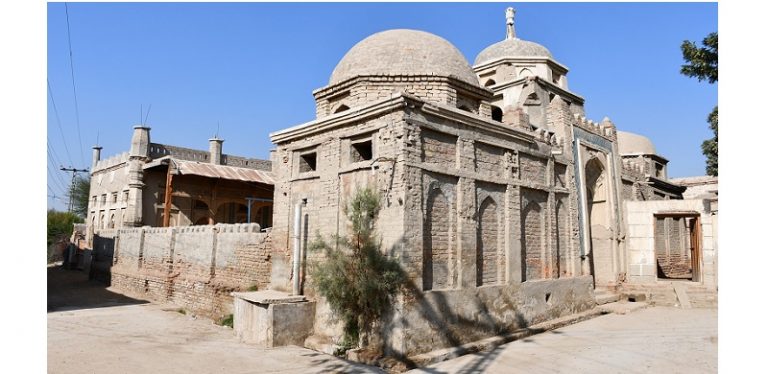
The shrine of Maulana Taj Mahmood Amroti is frequented by many people, who come from different districts of Sindh, Balochistan and Punjab to pay him homage for his active role in preaching Islam, protecting mosques and leading anti-colonial struggles in Sindh.
Zulfiqar Ali Kalhoro
Amrot Sharif is a historical village in Garhi Yasin taluka in the Shikarpur district. It is located about 9 km south of Garhi Yasin town. The village is famous for two historical mosques and the dargah of Maulana Taj Mahmood Amroti. The earliest Jamia mosque in the village is said to have been built by the village landlord Masti Khan Dal, who was known for his generosity. Like mystics, the landed elite of villages also built grand mosques in their respective villages.
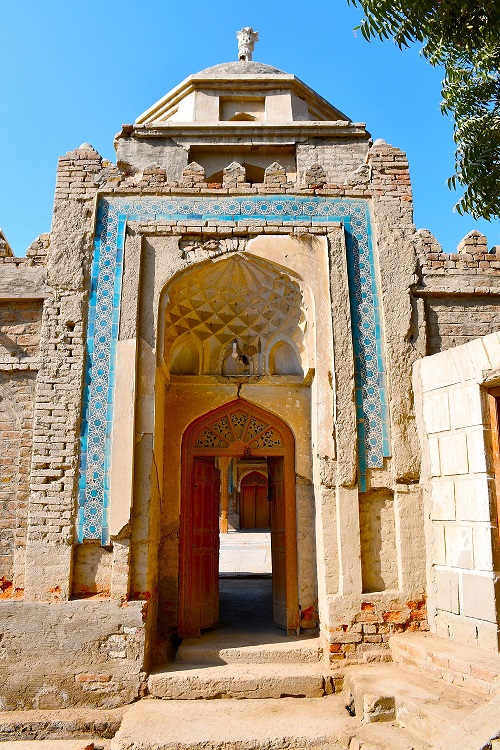
It is said that Masti Khan Dal employed the most famous masons and wood carvers of Shikarpur to build the mosque. The Jamia mosque is built in a rectangular plan with an elegant portal that is crowned with a dome. There is a decorative band of glazed blue tiles that adorns the main portal of the mosque. A similar scheme of decoration can also be seen on a central door that leads to the main prayer hall of the mosque.
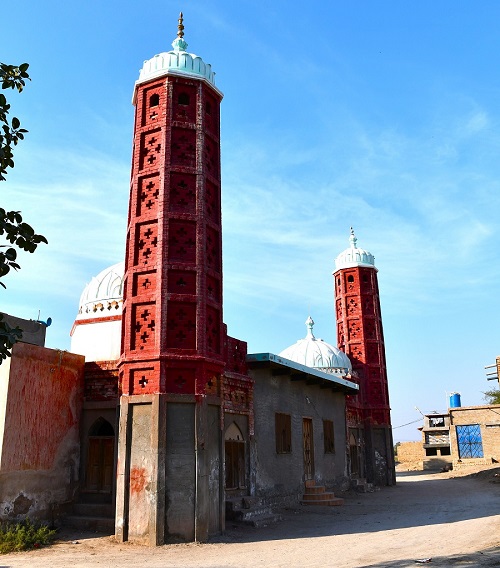
A distinctive feature of the mosque are the domed chambers that flank the main portal of the mosque. Generally, one can see a single dome on the main gateway to the mosque. But this innovation was adopted by the Shikapuri masons to place domes on the flanking chambers of the portal, which were used for guests and the Pesh Imam. Similar domed chambers are also seen in the dargah mosque in Amrot Sharif. This is a peculiarity of the mosques of Amrot Sharif and is not seen in any other mosque in Garhi Yashin taluka. One enters through a portal to the spacious courtyard of the Jamia mosque of Masti Khan Dal. Recently, both domes have partially collapsed in the rains that devastated Sindh.
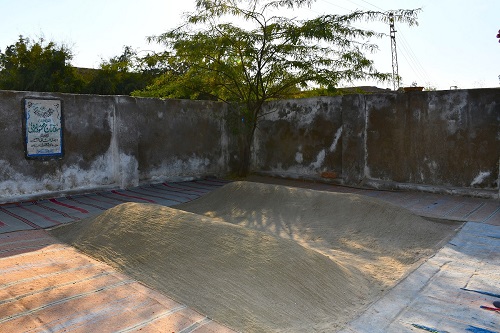
The wooden verandah is another peculiarity of the Jamia mosque. The covered verandah of the mosque has six arched entrances with grilled panels. The roof of the verandah stood on five pillars. The grilled panels bear both floral and geometric designs. The wooden verandah brackets are also decorative, and they support the soffit.
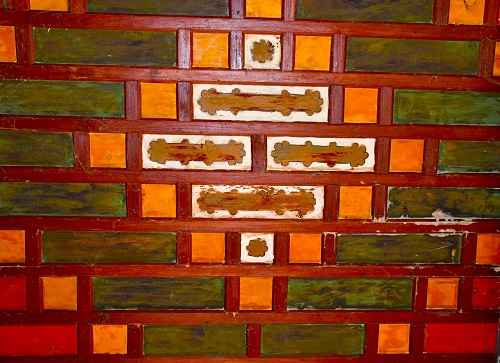
The painted wooden ceiling of the verandah is one of the most spectacular in terms of ornamentation and variety of motifs. Amongst those, the sun motif is the most prominent, which is not seen in any other mosque in Garhi Yashin taluka. Three doorways from the wooden verandah open to the main prayer hall of the mosque. The painted wooden ceiling of the main prayer hall is noted for its geometric designs. The builder of the mosque also especially focused on the provision of ventilation and natural lighting to the interior of the mosque. Two rows of windows were made on the western wall to properly provide light and ventilation to the interior prayer chamber of the mosque. Four windows were also made on the eastern wall of the mosque.
Panels and false arches were made for decoration purposes on the western wall. On the four panels are painted the names of Allah and Muhammad (peace be upon him). The mihrab section of the western wall is adorned with glazed tiles. There is an inscription above the mihrab that bears the date of the construction of the mosque in 1309 AH / 1891 AD. This mosque is currently in a bad state of preservation and needs to be renovated by the authorities concerned.
Maulana Taj Mahmood Amroti was an eminent Qadiri Sufi who played an important role in the Khilafat, Hijrat and Reshmi Rumal movements
Another historical mosque in Amrot Sharif is believed to have been built by Maulana Taj Mahmood Amroti, a Sufi scholar who wrote several books on Hadith, Fiqah, Tafsir and Sufism. He also translated the Holy Quran into Sindhi. He also played a key role in anti-imperialist movements. As per the inscription on the wooden door of the mosque, it was built in 1321 AH / 1904 AD.
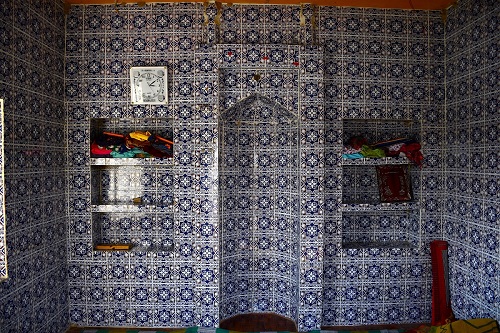
According to Syed Mahmood Shah Bukhari (2003) the author of Azadi Jo Imam Maulana Taj Mahmood Amroti, the Sufi, scholar, social reformer and active member of the Khilafat movement Maulana Taj Mahmood Amroti was born in 1857 in Deewani near Piryalo village in the Khairpur district. His father Abdul Qadir Shah Alias Bhoral Shah was also a religious scholar.
It is known that Maulana Taj Mahmood Amroti received his early education from his father. It is said that Maulana Taj Mahmood Amroti also studied under the guidance of Maulana Abdul Qadir Panhwari, who was a disciple of Khalifo Muhammad Yaqub Humayouni (d. 1856) – who was himself a Khalifo (deputy) of Maulana Abdul Haleem Kandvi (d. 1838). Maulana Taj Muhammad Amroti also learned the Persian and Arabic languages from Maulana Abdul Qadir Panhwari at Pir-Jo-Goth Madrassah in the Khairpur district. Later his father migrated from Deewani village to Amrot Sharif.
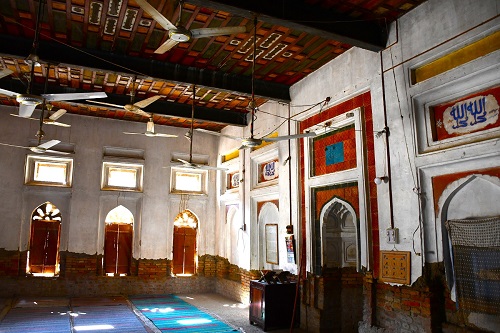
Maulana Taj Mahmood Amroti was an eminent Qadiri Sufi who played an important role in the Khilafat, Hijrat and Reshmi Rumal movements – as well as the protection of mosques during the construction of the Khirthar canal. Dr. Sibghatullah Indhar (2020), writes in Hayat Hazrat Halejvi that Maulana Taj Mahmood Amroti was initiated into the Qadiri Silsila by Hafiz Muhammad Siddique Bharchundi (d. 1890), who was a Khalifo (deputy) of Syed Muhammad Hassan Jilani (d.1838) of Sui Sharif, who was himself a Khalifo of Pir Muhammad Rashid Shah alias Rozay Dhani (d. 1818). It is said that on the instructions of his spiritual mentor, he preached the Qadiriyya-Rashiddiya silsila and established a mosque and madrassah in Amrot Sharif.
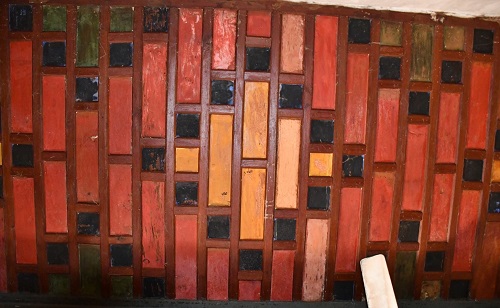
In fact, Amrot Sharif became a thriving center of the Qadiriyya-Rashiddiya silsila during the time of Maulana Taj Mahmood Amroti. Many people studied under his supervision in his madrassah and became his deputies and disciples. Some of the prominent deputies of Maulana Taj Mahmood Amroti include Khalifo Maulana Abdul Aziz Tharechani (d. 1950), Maulana Hammadullah Halejvi (d. 1962), Khalifo Mian Muhammad Saleh (d.1942) of Baiji Sharif, Syed Din Muhammad Shah (d.1973) of Mena village, Maulana Ahmed Ali Lahori (d.1962), Khalifo Hafiz Abdul Aziz of Kalabagh and others.
There used to be a small mosque at Amrot Sharif which could not accommodate the growing numbers of his followers and disciples on the eve of special religious events. He decided to build a grand mosque in its stead and employed the best masons in Shikarpur for its construction. Syed Mahmood Shah Bukhari (2003) believes that the most famous mason of Shikarpur, Abdul Rahim Soomro, constructed the Dargah mosque. He was assisted by six other masons. This mosque was also noted for woodwork and painting which were lost when the old mosque was demolished in 2007 or 2008 to build a new mosque. Only two minarets and hujars (rooms) are original – and these were built during the time of Maulana Taj Mahmood Amroti.
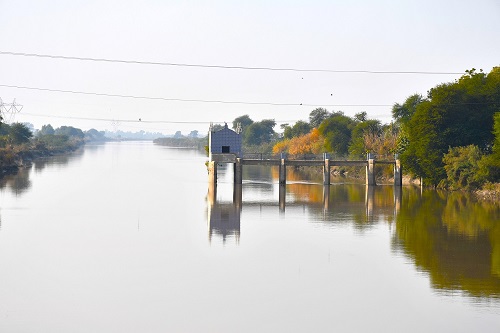
As we noted, Maulana Taj Mahmood Amroti played a leading role in anti-colonial struggles such as the Khilafat and Hijrat movements. Amrot Sharif itself became a centre of Khilafat movement activities. Professor Shams Sabir (2004), who wrote the article “Shikarpur jo Tehreek Khilafat men Hiso” which was published in the book Shikarpur: Tehqeeq and Tarikh compiled by Khalil Moryani, believes that Maulana Ubaidullah Sindhi (d. 1944) came to Amrot Sharif in the month of Shawal in 1308 AH / 1891 AD, where he stayed for seven years. Sarah F.D. Ansari (1992) writes in Sufi Saints and State Power: The Pirs of Sind, 1843-1947: “Maulana Ubaidullah Sindhi stayed at Amrot, where he set up the press Mahmud al Maktabah and brought out a journal named Hidayat al-Akhwan.”
Maulana Taj Mahmood Amroti also played the main role in the protection of mosques which were to be demolished during the construction of the Khirthar canal in 1923. He resisted and vehemently opposed it. He wrote letters to the Collector, the engineering department and other officials to chalk out a plan to modify the course of the canal to save the mosques. His consistent voice and resistance resulted in protecting a few mosques. Pani-Wari-Masjid or Juneja Masjid was one such mosque, which was situated on the route of the Khirthar canal, and it was saved.

According to Syed Abdul Qadir Shah son of Syed Muhammad Shah Amroti (d.1987), during the era of the second Gaddi Nashin of the dargah of Maulana Taj Mahmood Amroti, in order to approach the mosque, a bridge with five pillars was built. Later, two more pillars were constructed, and the mosque was decorated with ceramic tiles in 1989.

The dargah (shrine) of Maulana Taj Mahmood Amroti is the most sacred place for his followers in Amrot Sharif. It is located north of the dargah mosque. There are about ten graves inside the wall enclosure, prominent amongst which are those of Maulana Taj Mahmood Amroti himself and his nephews Syed Nizamuddin Shah Amroti, Syed Muhammad Shah Amroti, and others. Syed Nizamuddin Shah Amroti was the first custodian of the dargah of Maulana Taj Muhammad Amroti. We know that Maulana Taj Mahmood Amroti had one son Hasan Shah, who died at the age of 12.
After the death of Maulana Taj Mahmood Amroti, Syed Nizamuddin became the Gaddi Nashin of his dargah.
The shrine of Maulana Taj Mahmood Amroti is frequented by many people, who come from different districts of Sindh, Balochistan and Punjab to pay him homage for his active role in preaching Islam, protecting mosques and leading anti-colonial struggles in Sindh.
__________________
 Dr. Zulfiqar Ali Kalhoro, an anthropologist, has authored 13 books: ‘Symbols in Stone: The Rock Art of Sindh’, ‘Perspectives on the art and architecture of Sindh’, ‘Memorial Stones: Tharparkar’ and ‘Archaeology, Religion and Art in Sindh’. He may be contacted at: zulfi04@hotmail.com
Dr. Zulfiqar Ali Kalhoro, an anthropologist, has authored 13 books: ‘Symbols in Stone: The Rock Art of Sindh’, ‘Perspectives on the art and architecture of Sindh’, ‘Memorial Stones: Tharparkar’ and ‘Archaeology, Religion and Art in Sindh’. He may be contacted at: zulfi04@hotmail.com
Courtesy: The Friday Times Naya Daur Lahore (Published on January 6, 2023)